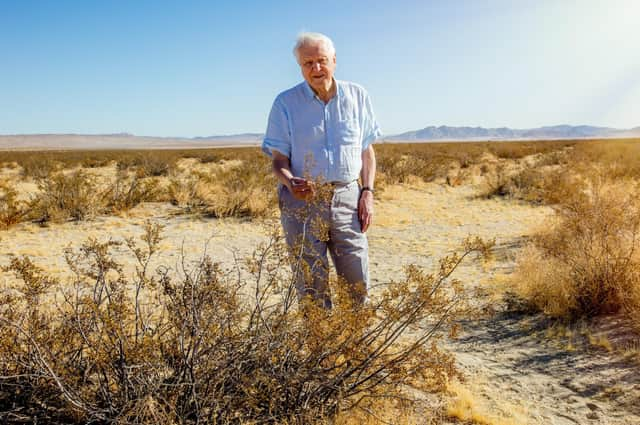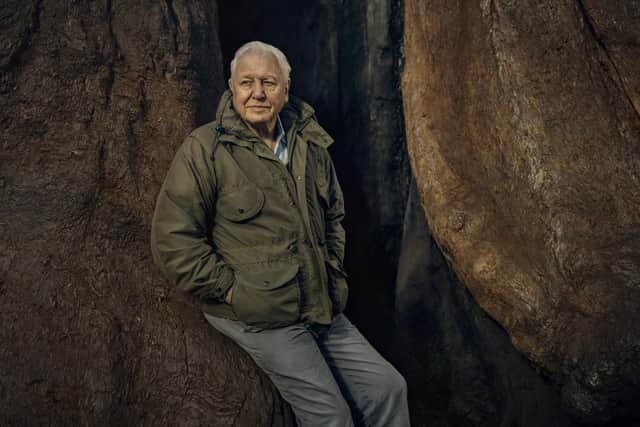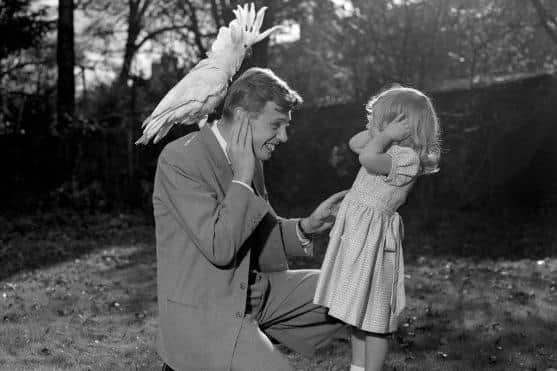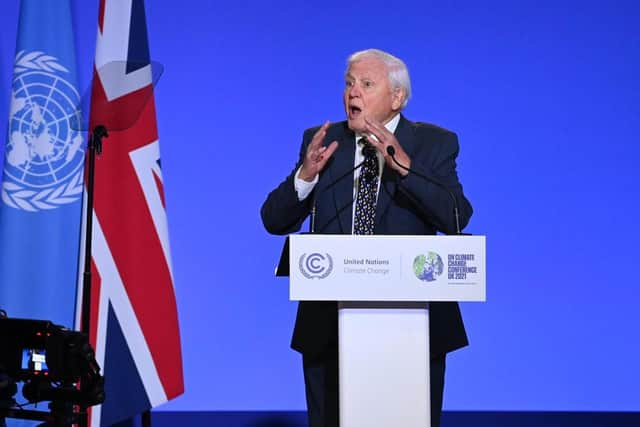SIR DAVID ATTENBOROUGH: “Why we must take jolly good care of this planet”


Drifting across the dewy lawns of London’s Kew Gardens, the unmistakable voice of Sir David Attenborough has caused countless passing visitors to do a double take. After all, it’s not every day you spot the 95-year-old naturalist and broadcaster perched casually upon the gnarled root of an old oak tree.
On this overcast spring morning, the BBC Studios’ renowned Natural History Unit are on location.
Advertisement
Hide AdAdvertisement
Hide AdIt’s a shoot that marks five years since filming first began for the five-part BBC documentary series The Green Planet – a period of time that has seen the team travel the world, capturing footage of the rarest and most intriguing plant-life imaginable.


“The world has suddenly become plant conscious,” Sir David reflects as he adds there has been “a revolution worldwide in attitudes towards the natural world in my lifetime”.
We have seen, he explains: “An awakening and an awareness of how important the natural world is to us all.
“An awareness that we would starve without plants, we wouldn’t be able to breathe without plants.
Advertisement
Hide AdAdvertisement
Hide Ad“The world is green – it’s an apt name (for the series), the world is green.


“And yet people’s understanding about plants, except in a very kind of narrow way, has not kept up with that. I think this will bring it home.”
It’s a concept that the show’s executive producer Mike Gunton concurs with.
“I wanted to do a Planet Earth for plants – because obviously your first thought with plants is, ‘It’s going to be like Gardeners’ World, it’s going to be dull’,” the Bafta-winning producer says, glancing over at Sir David as the broadcaster rehearses his lines.
Advertisement
Hide AdAdvertisement
Hide Ad“Planet Earth, I think, gives you a sense that there’s going to be some drama and some scale. It is constructed by habitat, so I wanted to replicate that. There’s tropical worlds, desert worlds, water worlds, seasonal worlds, and human worlds.”


As the first ever Creative Director of the BBC’s Natural History Unit, Gunton has played a pivotal role in the production of hit BBC documentaries including Planet Earth II, Dynasties and Africa.
It’s a proven track record that sees him ideally placed to take on the mammoth challenge posed by The Green Planet. Reuniting with Dynasties series producer Rupert Barrington, the series – which premiered on the eve of November’s COP26 summit in Glasgow – saw Sir David return to screens as series narrator.
Sir David hopes people, after watching the series, will begin to understand the primordial importance plants play in human life.
Advertisement
Hide AdAdvertisement
Hide AdThe veteran naturalist describes the world of plants as “a parallel world on which we depend, and which up to now we have largely ignored, if I speak on behalf of urbanised man.”
“Over half the population of the world according to the UN are urbanised, live in cities, only see cultivated plants and never see a wild community of plants.
“But that wild community is there, outside urban circumstances normally, and we depend upon it. And we better jolly well care for it,” he warns.
Recalling how the series proposal was met with the words “we’re ploughing a new furrow” from Sir David, Gunton says he knew the project needed to be an immersive viewing experience in order to capture the minds of viewers.
Advertisement
Hide AdAdvertisement
Hide Ad“The green ecosystems are an incredibly strong web which underpins all life – and because it’s so complex and so strong, it’s an unchallengeable Jenga tower,” says Gunton.
“What’s been happening is that we’ve been pulling the bricks out, but because we’re plant-blind, we haven’t really cared or noticed that we’ve pulled these bricks out.
“As we know, with a Jenga tower, if you just pull that last brick out, the whole thing collapses.
“What we’re trying to say is, be more aware of those Jenga blocks, because if you knock down that tower, it’s curtains.”
Advertisement
Hide AdAdvertisement
Hide AdNoting the ever-present challenge of bringing the natural world to life, Gunton explains how the unit developed never-before-seen technology, resulting in a new approach to filmmaking.
Based upon a widely-used technique known as time-lapse photography – a process by which a moving object is photographed consistently over a period of time and when played back, appears as a fast-forwarded video – the concept emerged after producer Paul Williams chanced upon a YouTube video uploaded by American visual engineer, Chris Field.
Already a fan of botanical photography, Field had tinkered with existing electronics to create a customised camera capable of capturing the movement of plant life.
Together with the BBC’s in-house team, they set about developing the technology in order to not only capture a simple time-lapse, but allow viewers to travel along the rainforest floor alongside plants and insects.
Advertisement
Hide AdAdvertisement
Hide AdIt’s a project that also saw the Natural History Unit embrace drone technology – a more eco-friendly and immersive alternative to helicopters.
Harnessing the skills of two competitive first-person-view drone pilots, the drones were able to weave through the rainforest canopy at high speed, capturing footage unlike anything previously seen.
Recounting how the five year production saw the team – including Sir David, travel the world in search of exotic plant life, it’s clear that age is but a number to the veteran naturalist.
“David is in his 90s, so we had to be quite careful about the number of locations and the amount of time away, but we managed to [go] to all the habitats,” says Gunton, listing off a swathe of trips across South America and Europe.
Advertisement
Hide AdAdvertisement
Hide Ad“We’ve been to rainforests, deserts, water worlds, and the Arctic – we actually even went to the Arctic Circle.”
The team also travelled to Costa Rica, visiting La Selva Biological Station – and what they saw there should bring hope, as the research centre has become famous for giving vast swathes of their land back to the natural rainforest.
“Plants will rewire land for you, and that’s what David is saying,” says Gunton. “The planet heals itself, we just need to give it the chance to do it.”
‘I’M SWANNING AROUND THE WORLD LOOKING AT THE MOST FABULOUSLY INTERESTING THINGS’: A POTTED BIO OF SIR DAVID
Advertisement
Hide AdAdvertisement
Hide AdSir David Attenborough was born on May 8, 1926 in Isleworth, Middlesex, and grew up in College House on the campus of the University College, Leicester, where his father, Frederick, was principal.
He is the middle of three sons; his elder brother, Richard (died in 2014), became an actor and director, and his younger brother, John (died in 2012), was an executive at Italian car manufacturer Alfa Romeo.
Attenborough spent his childhood collecting fossils, stones, and natural specimens.
He spent much time in the grounds of the university.
Aged around 11, he heard that the zoology department needed a large supply of newts, which he offered through his father to supply for 3d each. The source was a pond right next to the department.
Advertisement
Hide AdAdvertisement
Hide AdIn 1936, Sir David and his brother Richard attended a lecture by Grey Owl (Archibald Belaney) at De Montfort Hall, Leicester, and were influenced by his advocacy of conservation.
According to Richard, David was: “Bowled over by the man’s determination to save the beaver, by his profound knowledge of the flora and fauna of the Canadian wilderness and by his warnings of ecological disaster should the delicate balance between them be destroyed.
“The idea that mankind was endangering nature by recklessly despoiling and plundering its riches was unheard of at the time, but it is one that has remained part of Dave’s own credo to this day.”
Sir David was educated at Wyggeston Grammar School for Boys in Leicester and won a scholarship to Clare College, Cambridge in 1945 to study geology and zoology.
Advertisement
Hide AdAdvertisement
Hide AdIn 1947, he was called up for national service in the Royal Navy and spent two years stationed in North Wales and the Firth of Forth.
In 1950, Attenborough married Jane Elizabeth Ebsworth Oriel. The couple had two children, Robert and Susan. Jane died in 1997.
Robert is a senior lecturer in bioanthropology at a university in Canberra and his daughter Susan is a former primary school headmistress.
Sir David had a pacemaker fitted in June 2013, as well as a double knee replacement in 2015.
Advertisement
Hide AdAdvertisement
Hide AdBut the ebullient naturalist and broadcaster’s passion for what he does remains undimmed despite his formidable age.
He is quoted as commenting in September 2013: “If I was earning my money by hewing coal I would be very glad indeed to stop. But I’m not.
“I’m swanning round the world looking at the most fabulously interesting things.
“Such good fortune!”
‘SURELY WORKING TOGETHER WE ARE POWERFUL ENOUGH TO SAVE THIS PLANET’ SIR DAVID TOLD COP26 CONFERENCE
Advertisement
Hide AdAdvertisement
Hide AdAt the COP26 summit in Glasgow on November 1 last year, Sir David Attenborough called on world leaders and climate change activists to be “motivated by hope rather than fear” to avoid climate catastrophe.
Speaking in front of an audience that included the US president, Joe Biden, at the conference’s opening ceremony, the broadcaster and naturalist said humanity was “already in trouble”.
He also appealed to the political leaders and heads of state gathered for the two-week summit to commit to holding global temperature rises to 1.5C above pre-industrial levels, the lower of two limits set out in the 2015 Paris climate agreement.
Sir David said: “Everything we have achieved in the last 10,000 years has been enabled because of the [climate] stability during this time.
Advertisement
Hide AdAdvertisement
Hide Ad“The global temperature has not wavered over this period by more than either plus or minus one degree Celsius – until now. We are already in trouble. The stability we all depend on is breaking.
“This story is one of inequality as well as instability. Today, those who have done the least to cause this problem are among those to be hardest hit. Ultimately, all of us will feel the impact, some of which is unavoidable.
“Is this how our story is due to end?
“A tale of the smartest species doomed by that all too human characteristic of failing to see the bigger picture in pursuit of short-term goals?”
He added his voice to increasingly growing calls for world leaders to thrash out a commitment to the 1.5C temperature limit and called on young people to “rewrite our story”.
Advertisement
Hide AdAdvertisement
Hide Ad“Perhaps the fact that the people most affected by climate change are no longer some imagined future generation but young people alive today, perhaps that will give us the impetus we need to rewrite our story.
“To turn this tragedy into a triumph – we are after all the greatest problem solvers to have ever existed on Earth. We now understand this problem, we know how to stop the number rising and put it in reverse.
“We must recapture billions of tonnes of carbon from the air.”
Attenborough also highlighted that “no nation has completed its development because no advanced nation is yet sustainable”, and demanded “all nations have a good standard of living and a modest [carbon] footprint”.
Advertisement
Hide AdAdvertisement
Hide AdHe concluded: “The people alive now and the generation to come will look at this conference and consider one thing – did the number stop rising and start to drop as a result of commitments made here?
“There’s every reason to believe that the answer can be yes.
“If working apart we are forces powerful enough to destabilise our planet, surely working together we are powerful enough to save it.”
The Green Planet is available to watch on the BBC iPlayer.
A message from the Editor:
Thank you for reading this story on our website. While I have your attention, I also have an important request to make of you.
Advertisement
Hide AdAdvertisement
Hide AdWith the coronavirus lockdown having a major impact on many of our advertisers - and consequently the revenue we receive - we are more reliant than ever on you taking out a digital subscription.
Subscribe to newsletter.co.uk and enjoy unlimited access to the best Northern Ireland and UK news and information online and on our app. With a digital subscription, you can read more than 5 articles, see fewer ads, enjoy faster load times, and get access to exclusive newsletters and content. Visit https://www.newsletter.co.uk/subscriptions now to sign up.
Our journalism costs money and we rely on advertising, print and digital revenues to help to support them. By supporting us, we are able to support you in providing trusted, fact-checked content for this website.
Ben Lowry
Editor